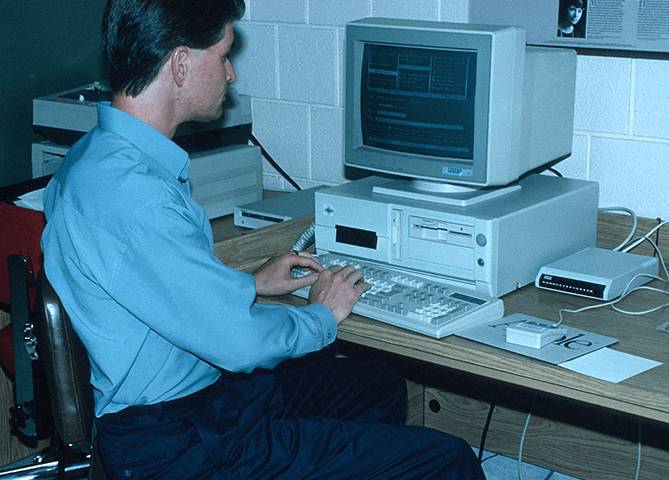Little Known Facts
In the early part of 1993, actualizing the academic BBS idea from coffee chat to practice was a series of rapid evolutionary steps in computing hardware and software. In addition, I had to learn each application, scrounge and build hardware, outside employment time. The initial prototype was the “1st Desk BBS” Mac software on a used donated old Mac SE with an old external 10 MB hard drive and one 14.4K modem, situated on a small table next to an available telephone outlet in the Chemistry, Biology, and Environmental Science department.
A faster computing system using MSDOS and Synchronet was implemented in the summer of 1993. Synchronet BBS software afforded a more complex BBS with functionality and speed beyond the aging Mac, which included multilevel security of forums and library. An Internet domain was acquired for the BBS. Originally the mtroyal.ab.ca domain name was selected but then handed it over to the IT department in exchange for the domain prefix – scitech.mtroyal.ab.ca – having Internet connectivity made it much easier to access the academic BBS from anywhere, anytime, rather than having to wait to login to the only 14.4K modem.
An interesting Synchronet add-on module for administration to the SciTech BBS provided a side feature of an automated sysop. This module created a “virtual system administrator” that would answer questions by endusers communicating with the BBS. I became aware of the impact of this “virtual system administrator” feature when a student asked me about the online conversation I had with them during the previous midnight. I had to explain to the student that it was a computer that they were communicating with, not me. However, the student was convinced that they had been communicating at a distance with another human, this experience expanded my view of education at a distance.
In the 1993 Fall term, students in the Faculty of Science and Technology had access to online courseware, open e-texts, forums, email, and support. The primary point of access was a computer with a modem. During late 1993, the Synchronet software was exchanged for MSDOS Worldgroup with a Local Area Network (LAN) cable and three 14.4K baud modems. Worldgroup provided similar security flexibility but extended features such as virtual whiteboards, chat, e-commerce, and connectivity to mainframes. During this period of time, LXR-Test was introduced as a way of asynchronous online testing, via runtime test packages that students downloaded and executed at their convenience. Eventually LXR-Test evolved into an online server that was able to run testing synchronously without having to download executables. However, such a feature required a separate computer due to the intense tasking operations of the testing software on the memory of the operating system, particularly with more than a few students accessing the system simultaneously.

In 1994, the SciTech BBS was demonstrated at the National Educational Computing Conference – NECC ’94 (1993-12-26 NECC_94 Proposal). Although, the BBS presentation was situated in the nether reaches of the conference facilities in the “Internet room,” the result was an overflowing audience with no standing room. The presentation was made in ClarisWorks and run on an Apple laptop donated by Apple Canada (equipment list). That experience demonstrated the gaps between student digital needs at a distance, financial feasibility, and growing Internet demand.
The educational BBS had a wealth of functionality with more than 16 simultaneous nodes with no degradation in connection, all on a 486 PC microcomputer. The 14.4K modems were upgrade to 56K modems, and the SciTech BBS was regularly accessed by institutions in Australia, New Zealand, Canada, Europe, and the United States Consulate in Calgary. The SciTech BBS included email, forums, teleconference, whiteboard, library, doors to mainframe computer for interactive computer managed learning modules, surveys and polls, online testing, databases, RipScrip, telnet, FTP, website hosting, accounting, multilevel security (class and key), video conference, and e-commerce. Worldgroup BBS software was stable with downtime only for momentary maintenance. There was no secondary computer for development, all design and development was happening in real time on the production machine. Many times I wondered what would happen if the computer electronics died. However, with a UPS and surge protection on all connections between the computer and peripherals, there was never a loss of equipment. Backup was basic copy to Zip drive and CD-R.
Students were accessing the SciTech BBS via Mosaic and Netscape web browsers, LAN, email clients, telnet, Worldgroup graphical client software for Windows and Mac. The MSWindows 95 operating system provided the graphical experience to interact with the SciTech BBS. Personal website building was an inherent feature for students, often used to promote their portfolios to potential employers. The promotion of the SciTech BBS had global and local community outreach.
Community Outreach Example
Date: Wednesday, March 15, 1995 10:20pm Electronic Mail
From: Guest Msg#: 5410
To: Sysop
Re: Environmental Tech Program
Hello,
i read the recent editorial in the Herald and found your
phone number in that article. i think this bbs is an excellant
idea. i was hoping to acquire some detailed information on the
environmental technology program offerred at MRC. If you could
please forward this email to the appropriate area i would be
forever in your debt. i can be reached at _redacted_@freenet.calgary.ab.ca
Thank you,
Scott
There were many institutional wide workshops for faculty and students on how to use the SciTech BBS. There was great interest from many other faculties on how to implement their own BBS to serve students. However, such bubble up innovations from staff had ripple effects on the agendas on certain departments of the institution who took exception to such digital diversity, from the perspectives of open control, excessively low cost finances, and academic freedom. Such tensions would eventually doom an innovative project that had served students and faculty locally, regionally, and globally.
